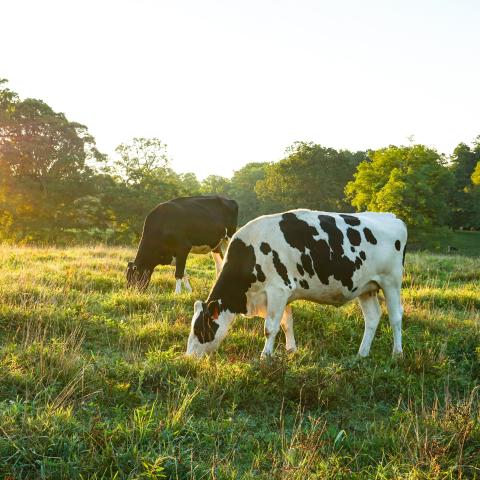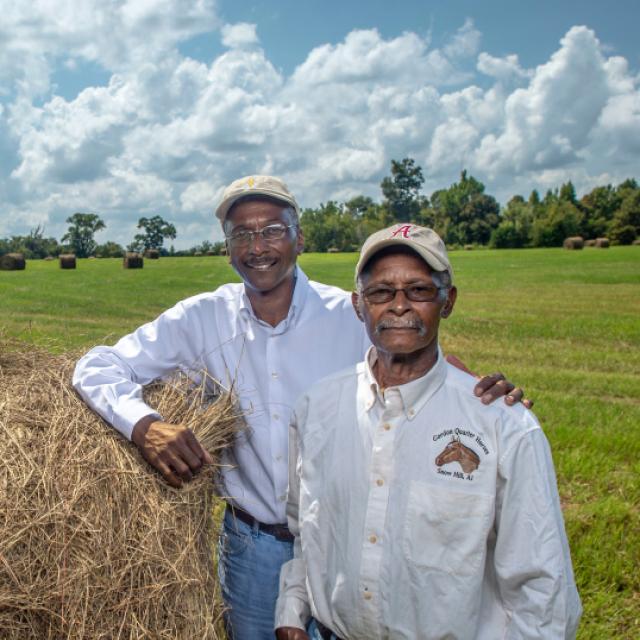
Press Release


The Environmental Quality Incentives Program (EQIP) is NRCS’ flagship conservation program that helps farmers, ranchers and forest landowners integrate conservation into working lands.

The Environmental Quality Incentives Program (EQIP) is a voluntary conservation program that helps producers in a way that makes agricultural production and environmental quality as compatible goals.
While applications are accepted on a continuous basis, NRCS establishes application "cut-off" or submission deadlines for evaluation, ranking and approval of eligible applications. To be considered for current available funding, applicants should have their applications in the local field office by Nov. 7, 2025.
Benefits
Eligible program participants receive financial and technical assistance to implement conservation practices, or activities like conservation planning, that address natural resource concerns on their land. Payments are made to participants after conservation practices and activities identified in an EQIP plan of operations are implemented. Contracts can last up to ten years in duration.
Eligibility
Agricultural producers and owners of non-industrial private forestland are eligible to apply for EQIP. Eligible land includes cropland, rangeland, pastureland, non-industrial private forestland and other farm or ranch lands.
Socially disadvantaged, beginning and limited resource farmers, and veterans are eligible for an increased payment rate and may receive advance payment of 50 percent to purchase materials and services needed to implement conservation practices included in their EQIP contract.
Applicants must:
Additional restrictions and program requirements may apply.
How to Apply / Accepting Applications
EQIP applications are accepted on a continuous basis, however, NRCS establishes application "cut-off" or submission deadline dates for evaluation, ranking and approval of eligible applications. EQIP is open to all eligible agricultural producers and submitted applications may be considered or evaluated in multiple funding pool opportunities.
Visit your local USDA Service Center to apply or visit www.nrcs.usda.gov/getstarted.
NRCS will help eligible producers develop an EQIP plan of operations, which will become the basis of the EQIP contract.
EQIP applications will be ranked based on a number of factors, including the environmental benefits and cost effectiveness of the proposal.
Input from Outside Groups, Agencies, and Citizens: The list of eligible practices in North Carolina, payment rates and limits, eligible resource concerns, and state scoring criteria are developed based on input and recommendations from Landowners, Partners, and State Technical Committee (STC). The STC is made up of representatives from various agribusinesses, producer groups, conservation organizations, and federal, state, and tribal government agency representatives.
Applicants are responsible for completing and filing all application and eligibility paperwork as required. If funded, participants are required to sign a contract and agree to implement the planned conservation practices to NRCS standards and specifications as scheduled. Starting a practice prior to written contract approval will result in the ineligibility of that practice for EQIP assistance.
USDA’s Natural Resources Conservation Service (NRCS) reminds historically underserved producers, who are participating in the Environmental Quality Incentives Program (EQIP), of the advance payment option. This option allows them to get conservation practice payments in advance of practice implementation. EQIP provides financial and technical assistance to address natural resource concerns and to deliver environmental benefits, such as improved water and air quality, conserved ground and surface water, reduced soil erosion and sedimentation, and improved or created wildlife habitat. In fiscal 2024, NRCS invested $52.5 million in North Carolina through EQIP to implement conservation practices.
A historically underserved producer is described as one of the below:
Under the advance payment option, such producers may request payments when they have final designs and job sheets and are ready to begin their EQIP practices. Advance payments provide 50 percent of the payment rate for each practice. The funds must be spent within 90 days of receipt and practices must be completed as agreed to in an EQIP plan of operations. Producers also may opt to have NRCS pay the contractors or vendors directly.
EQIP practices include vegetative practices, structural practices, management practices, and other improvements that further program goals such as conservation activity plans.
Any applicant who has eligible land may submit an application for participation in ACEP, EQIP, CSP, or RCPP. North Carolina will develop ranking criteria to prioritize and subsequently fund applications addressing priority natural resource concerns in the state.
NRCS uses screening criteria to evaluate applications for conservation programs like EQIP to ensure resources are directed towards addressing priority conservation needs. These criteria help determine if an applicant is eligible and if their proposed project aligns with NRCS goals and priorities. The criteria vary based on the specific program and conservation practices involved, but generally focus on resource concerns, land use, and the applicant's commitment to conservation. Key aspects of NRCS screening criteria:
Resource Concerns:
Land Use and Eligibility:
Program-Specific Criteria:
Ranking and Prioritization:
Documentation and Assessment:
Application reception periods and ranking deadlines will be set for all programs in order to select the highest ranked applications for funding, based on applicant eligibility and how well applications address the resource concern identified. In Fiscal Year 2025 NRCS will use the Conservation Assessment Ranking Tool (CART) for all program ranking.
The Conservation Assessment Ranking Tool (CART) is designed to assist NRCS conservation planners as they assess site vulnerability, existing conditions, and identify potential resource concerns on a unit of land. CART results are then used to support conservation planning activities for the client. CART also captures this information to prioritize programs and report outcomes of NRCS investments in conservation.
CART is a decision support system designed to provide a consistent, replicable framework for the conservation planning process based on geospatially referenced information, client provided information, field observations as appropriate, and planner expertise. Site evaluations for existing management and conservation efforts are then compared to the quality criteria threshold to determine what level of conservation effort is needed to address resource concerns on the participant’s land.
In general, resource concerns fall into one of three categories for the assessment method used to assess and document a resource concern:
After identifying resource concerns and answering existing condition questions, planned conservation practices and activities can be added to the existing condition to determine the state of the management system. Supporting practices may be necessary to support the primary conservation practices and activities and will be identified as necessary, but do not add conservation management points to the total. A comprehensive list of Conservation Practices and Activities and their points towards addressing each resource concern by land use is available as an attachment to this document.
If the client is interested in financial assistance, CART will directly and consistently transfer inventory and assessment information, along with client decisions related to conservation practice adoption, to the ranking tool to avoid duplication, increase prioritization on critical areas based on geospatial priorities and site-specific data, and provide better outcomes and a framework for continuous improvement.
CART will identify applicable financial assistance ranking pools to provide the most advantageous situation for the client and to help planners prioritize workload toward those clients who are most likely to receive funding.
CART Ranking Criteria will use the following guiding principles:
CART will utilize a set of National Ranking Templates created by National Program Managers for all NRCS programs and initiatives. The National Ranking Templates contain four parameters that will be customized for each program to reflect the national level ranking priorities. The four parameters are:
North Carolina has created specific ranking pools that have been used for many years. Ranking pools will be modified to fit the CART template. Ranking pool customization allows states to focus funding on priority resource concerns and initiatives identified within the state.
The state ranking pools contain a set of questions that includes the following sections – applicability, category, program questions, and resource questions. Program participants will be considered for funding in all applicable ranking pools by program.
CART Ranking Pools are customized to incorporate locally led input and will evaluate the participant’s assessed practice schedule for five main areas:
The 2018 Farm Bill requires that NRCS dedicate financial assistance dollars in the following categories:
A Conservation Activity Plan or CAP can be developed for producers to identify conservation practices needed to address a specific natural resource need. Typically, these plans are specific to certain kinds of land use such as:
A CAP can also address a specific resource need, such nutrient management or an air quality concern. With a CAP plan, producers can then apply for financial assistance to implement the needed conservation practices.
Julius George, Assistant State Conservationist for Programs, 919-873-2104
The Environmental Quality Incentives Program (EQIP) provides financial and technical assistance to agricultural producers and non-industrial forest managers.
Learn MoreThe Agriculture Improvement Act of 2018 (2018 Farm Bill) includes provisions that address socially disadvantaged, beginning, limited resource, and veteran farmers and ranchers (“historically underserved producers”).
Learn MoreThe 2018 Farm Bill was enacted on December 20, 2018. The Farm Bill continues its strong support for conservation efforts of America’s farmers and ranchers through reauthorization and expanded flexibility of NRCS conservation programs.
Learn MoreContact your local service center to start your application.
Do you farm or ranch and want to make improvements to the land that you own or lease?
Natural Resources Conservation Service offers technical and financial assistance to help farmers, ranchers and forest landowners.

To get started with NRCS, we recommend you stop by your local NRCS field office. We’ll discuss your vision for your land.
NRCS provides landowners with free technical assistance, or advice, for their land. Common technical assistance includes: resource assessment, practice design and resource monitoring. Your conservation planner will help you determine if financial assistance is right for you.
We’ll walk you through the application process. To get started on applying for financial assistance, we’ll work with you:
Once complete, we’ll work with you on the application, or CPA 1200.
Applications for most programs are accepted on a continuous basis, but they’re considered for funding in different ranking periods. Be sure to ask your local NRCS district conservationist about the deadline for the ranking period to ensure you turn in your application in time.
As part of the application process, we’ll check to see if you are eligible. To do this, you’ll need to bring:
If you don’t have a farm number, you can get one from USDA’s Farm Service Agency. Typically, the local FSA office is located in the same building as the local NRCS office. You only need a farm number if you’re interested in financial assistance.
NRCS will take a look at the applications and rank them according to local resource concerns, the amount of conservation benefits the work will provide and the needs of applicants. View Application Ranking Dates by State.
If you’re selected, you can choose whether to sign the contract for the work to be done.
Once you sign the contract, you’ll be provided standards and specifications for completing the practice or practices, and then you will have a specified amount of time to implement. Once the work is implemented and inspected, you’ll be paid the rate of compensation for the work if it meets NRCS standards and specifications.